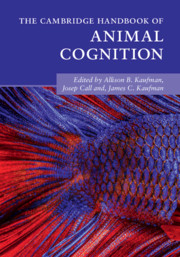Book contents
- The Cambridge Handbook of Animal Cognition
- The Cambridge Handbook of Animal Cognition
- Copyright page
- Dedication
- Contents
- Figures, Tables, and Boxes
- Contributors
- Acknowledgments
- Introduction
- Part I Communication and Language
- Part II Memory and Recall
- Part III Social Cognition
- Part IV Social Learning and Teaching
- Part V Numerical and Quantitative Abilities
- Part VI Innovation and Problem-Solving
- 28 Innovation and Problem-Solving Overview
- 29 General Intelligence (g) in Mice
- 30 Bowerbird Innovation and Problem-Solving
- 31 Parrot Innovation
- 32 Innovation in Marine Mammals
- 33 Innovation in Capuchin Monkeys
- 34 Innovation and Problem-Solving in Orangutans
- 35 Do Apes and Monkeys Know What They (Don’t) Know?
- 36 Decision Making in Animals
- Index
- References
32 - Innovation in Marine Mammals
from Part VI - Innovation and Problem-Solving
Published online by Cambridge University Press: 01 July 2021
- The Cambridge Handbook of Animal Cognition
- The Cambridge Handbook of Animal Cognition
- Copyright page
- Dedication
- Contents
- Figures, Tables, and Boxes
- Contributors
- Acknowledgments
- Introduction
- Part I Communication and Language
- Part II Memory and Recall
- Part III Social Cognition
- Part IV Social Learning and Teaching
- Part V Numerical and Quantitative Abilities
- Part VI Innovation and Problem-Solving
- 28 Innovation and Problem-Solving Overview
- 29 General Intelligence (g) in Mice
- 30 Bowerbird Innovation and Problem-Solving
- 31 Parrot Innovation
- 32 Innovation in Marine Mammals
- 33 Innovation in Capuchin Monkeys
- 34 Innovation and Problem-Solving in Orangutans
- 35 Do Apes and Monkeys Know What They (Don’t) Know?
- 36 Decision Making in Animals
- Index
- References
Summary
In humans, creativity or innovation (researchers draw a distinction, but for our purposes the two terms will be used interchangeably) is often defined as the ability to create things that are both novel and appropriate (Sternberg, Kaufman, & Pretz, 2002). A dress can be beautifully designed and crafted, but if it isn’t task appropriate – for example, if it can’t be worn – many researchers would not call it creative.In animals, the same “novel and appropriate” standard can be used, but the terms take on very different meaning, in many cases playing directly into the survival of an individual or a species.Of all species, marine mammals are especially noted for their intelligence and innovation in both the wild and under human care, and their innovative abilities in a variety of situations will be briefly reviewed here.Subsequently, a novel way of measurement of these abilities based on the Torrance Tests of Creative Thinking, a common test of creativity used in humans, will be presented.
- Type
- Chapter
- Information
- The Cambridge Handbook of Animal Cognition , pp. 710 - 720Publisher: Cambridge University PressPrint publication year: 2021



